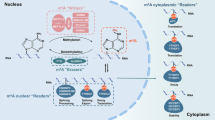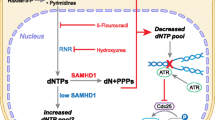Abstract
Cancer cells require continuous synthesis of nucleotides for their uncontrolled proliferation. Deoxy thymidylate kinase (DTYMK) belongs to the thymidylate kinase family and is concerned with pyrimidine metabolism. DTYMK catalyzes the ATP-based conversion of deoxy-TMP to deoxy-TDP in both de novo and salvage pathways. Different studies demonstrated that DTYMK was increased in various types of cancers such as hepatocellular carcinoma, colon cancer, lung cancer, etc. Increased level of DTYMK was associated with poorer survival and prognosis, stage, grade and size of tumor, cell proliferation, colony formation, enhanced sensitivity to chemotherapy drugs, migration. Some studies were showed that knockdown of DTYMK reduced the signaling pathway of PI3K/AKT and downregulated expression of CART, MAPKAPK2, AKT1 and NRF1. Moreover, some microRNAs could suppress DTYMK expressions. On the other hand based on the TIMER database, the infiltration of macrophages, dendritic cells, neutrophils, B cells, CD4+ T cell and CD8+ T cell is affected by DTYMK. In the present review, we describe the genomic location, protein structure and isoforms of DTYMK and focus on its role in cancer development.


Similar content being viewed by others
References
Wang T, Hughes NW, Krupczak KM, Post Y, Wei JJ, Lander ES, Sabatini DM. Identification and characterization of essential genes in the human genome. Science (NY). 2015;350(6264):1096–101.
Chen WH, Chen X, Zhao XM, Bork P. OGEE v2: an update of the online gene essentiality database with special focus on differentially essential genes in human cancer cell lines. Nucleic Acids Res. 2017;45:940–4.
Lama W-LYC, Linga T, Wonga K, Lawa C. Deoxythymidylate kinase, DTYMK, is a novel gene for mitochondrial DNA depletion syndrome. Clin Chim Acta. 2019;496:93–9.
Sun F, et al. Inhibition of DTYMK significantly restrains the growth of HCC and increases sensitivity to oxaliplatin. Cell Death Dis. 2021;12(12):1093.
Vanoevelen JMB, Grashorn J, Lambrichs E, Kamsteeg E-J, Bok L, Wevers R, Van der Knaap M, Bugiani M, Frisk JMH, et al. DTYMK is essential for genome integrity and neuronal survival. Acta Neuropathol. 2022;143:245–62.
Liu YM, Cowley G, Carretero J, Liu Q, Nieland T, Xu C, Cohoon T, Gao P, Zhang Y, et al. Metabolic and functional genomic studies identify deoxythymidylate kinase as a target in LKB1-mutant lung cancer. Cancer Discov. 2013;3:870–9.
Hu C-M, Chang Z-F. Synthetic lethality by lentiviral short hairpin RNA silencing of thymidylate kinase and doxorubicin in colon cancer cells regardless of the p53 status. Can Res. 2008;68(8):2831–40.
Chaudhary SK, Jeyakanthan J, Sekar K. Structural and functional roles of dynamically correlated residues in thymidylate kinase. Acta Crystallogr D. 2018;74(Pt 4):341–54. https://doi.org/10.1107/s2059798318002267.
Su J-Y, Sclafani RA. Molecular cloning and expression of the human deoxythymidylate kinase gene in yeast. Nucleic Acids Res. 1991;19(4):823–7.
Liang P, et al. Molecular characterization of the murine thymidylate kinase gene. Cell Growth Differ. 1995;6(10):1333–8.
Ke Y-YKP-Y, Hu C-M, Chang Z-F. Control of dTTP pool size by anaphase promoting complex/cyclosome is essential for the maintenance of genetic stability. Genes Dev. 2005;19(16):1920–33.
Evans DR, Guy HI. Mammalian pyrimidine biosynthesis: fresh insights into an ancient pathway. J Biol Chem. 2004;279(32):33035–8.
Löffler M, et al. Pyrimidine pathways in health and disease. Trends Mol Med. 2005;11(9):430–7.
Evans DR. Mammalian pyrimidine biosynthesis: fresh insights into an ancient pathway. J Biol Chem. 2004;279(32):33035–8.
Simmer JP, et al. Mammalian aspartate transcarbamylase (ATCase): sequence of the ATCase domain and interdomain linker in the CAD multifunctional polypeptide and properties of the isolated domain. Proc Natl Acad Sci USA. 1989;86(12):4382–6. https://doi.org/10.1073/pnas.86.12.4382.
Deans RM, et al. Parallel shRNA and CRISPR-Cas9 screens enable antiviral drug target identification. Nat Chem Biol. 2016;12(5):361–6. https://doi.org/10.1038/nchembio.2050.
Wittmann JG, et al. Structures of the human orotidine-5’-monophosphate decarboxylase support a covalent mechanism and provide a framework for drug design. Structure. 2008;16(1):82–92. https://doi.org/10.1016/j.str.2007.10.020.
Liou JY, et al. Characterization of human UMP/CMP kinase and its phosphorylation of D- and L-form deoxycytidine analogue monophosphates. Cancer Res. 2002;62(6):1624–31.
Greene BL, Nocera DG, Stubbe J. Basis of dATP inhibition of RNRs. J Biol Chem. 2018;293(26):10413–4. https://doi.org/10.1074/jbc.H118.003717.
Chen D, et al. Structural analyses of human thymidylate synthase reveal a site that may control conformational switching between active and inactive states. J Biol Chem. 2017;292(32):13449–58. https://doi.org/10.1074/jbc.M117.787267.
Cao DLJ, Kim B, Pizzorno G. Abnormalities in uridine homeostatic regulation and pyrimidine nucleotide metabolism as a consequence of the deletion of the uridine phosphorylase gene. J Biol Chem. 2005;280(22):21169–75.
Ostermann NS, Brundiers R, Konrad M, Reinstein J, Veit T, Goody RS, Lavie A. Insights into the phosphoryltransfer mechanism of human thymidylate kinase gained from crystal structures of enzyme complexes along the reaction coordinate. Structure. 2000;8:629–42.
Hu Frisk J, et al. Structural and functional analysis of human thymidylate kinase isoforms. Nucleosides Nucleotides Nucleic Acids. 2022;41(3):321–32. https://doi.org/10.1080/15257770.2021.2023748.
Yeh H-W, et al. Pyrimidine metabolic rate limiting enzymes in poorly-differentiated hepatocellular carcinoma are signature genes of cancer stemness and associated with poor prognosis. Oncotarget. 2017;8(44):77734.
Guo Y et al (2021) DTYMK expression predicts prognosis and chemotherapeutic response and correlates with immune infiltration in hepatocellular carcinoma. J Hepatocell Carcinoma 871–885.
Zhou T, et al. DTYMK promote hepatocellular carcinoma proliferation by regulating cell cycle. Cell Cycle. 2021;20(17):1681–91.
Heydari N, et al. Overexpression of serum MicroRNA-140-3p in premenopausal women with newly diagnosed breast cancer. Gene. 2018;655:25–9.
Nashtahosseini Z, et al. Circulating status of microRNAs 660–5p and 210–3p in breast cancer patients. J Gene Med. 2021;23(4): e3320.
He G, et al. Mir-148b-3p regulates the expression of DTYMK to drive hepatocellular carcinoma cell proliferation and metastasis. Front Oncol. 2021;11:5448.
Chen X, et al. Comprehensive analysis of DTYMK for estimating the immune microenvironment, diagnosis, prognosis effect in patients with lung adenocarcinoma. Aging (Albany NY). 2022;14(19):7866.
Wang W, et al (2016) Elevated expression of DTYMK is associated with poor prognosis in patients with non-small cell lung cancer. Int J Clin Exp Med 9(11).
Zhang Y et al (2022) Comprehensive analysis of DTYMK in pan-cancer and verification in lung adenocarcinoma. Biosci Rep 42(10):BSR20221170.
Lan T, et al. Deoxythymidylate kinase as a promising marker for predicting prognosis and immune cell infiltration of pan-cancer. Front Mol Biosci. 2022. https://doi.org/10.3389/fmolb.2022.887059.
Zhou L et al (2022) Relationship between up-regulation of DTYMK expression and immune infiltration for the prognosis of lung adenocarcinoma. Res Square. https://doi.org/10.21203/rs.3.rs-1693054/v1.
Wang H, et al. High expression levels of pyrimidine metabolic rate–limiting enzymes are adverse prognostic factors in lung adenocarcinoma: a study based on the cancer genome atlas and gene expression omnibus datasets. Purinergic Signal. 2020;16:347–66.
Liu Y, et al. Metabolic and functional genomic studies identify deoxythymidylate kinase as a target in LKB1-mutant lung canceridentifying Lkb1-mutant synthetic lethal targets. Cancer Discov. 2013;3(8):870–9.
Cicatiello L, et al. A genomic view of estrogen actions in human breast cancer cells by expression profiling of the hormone-responsive transcriptome. J Mol Endocrinol. 2004;32(3):719–75.
Chow L, et al (2012) 23P expression of beta-iii tubulin, Foxo 3 protein and deoxythymidine kinase in breast cancer patients receiving neoadjuvant chemotherapy. Ann Oncol 23:ii21.
Mir SM, et al. Melatonin: a smart molecule in the DNA repair system. Cell Biochem Funct. 2022;40(1):4–16.
Hu C-M, et al. Tumor cells require thymidylate kinase to prevent dUTP incorporation during DNA repair. Cancer Cell. 2012;22(1):36–50.
Hu C-M, et al. Thymidylate kinase is critical for DNA repair via ATM-dependent Tip60 complex formation. FASEB J. 2019;33(2):2017–25.
De Angelis PM, et al. Molecular characterizations of derivatives of HCT116 colorectal cancer cells that are resistant to the chemotherapeutic agent 5-fluorouracil. Int J Oncol. 2004;24(5):1279–88.
Zeinali P, et al. High dose of 3, 7-dimethyl-1-propargylxanthine induces cell death in YM-1 and KYSE30 cancer cell lines. Med Lab J. 2022;16(5):37–42.
Hamzeloo-Moghadam M, et al. Britannin, a sesquiterpene lactone, inhibits proliferation and induces apoptosis through the mitochondrial signaling pathway in human breast cancer cells. Tumor Biol. 2015;36:1191–8.
Yuka Y, et al. Correlation of ENT1, TK1, dNT, TMPK, and PCNA with 18F-FLT uptake in gastric cancer. J Nucl Med. 2009;50(Supplement 2):1764.
Zhao H, et al. Pan-cancer analysis of prognostic and immunological role of DTYMK in human tumors. Front Genet. 2022. https://doi.org/10.3389/fgene.2022.989460.
Zhou L et al (2022) Relationship between up-regulation of DTYMK expression and immune infiltration for the prognosis of lung adenocarcinoma. https://doi.org/10.21203/rs.3.rs-1693054/v1
Funding
No funding.
Author information
Authors and Affiliations
Corresponding author
Ethics declarations
Conflict of interest
The authors have no conflicts of interests to disclose.
Additional information
Publisher's Note
Springer Nature remains neutral with regard to jurisdictional claims in published maps and institutional affiliations.
Rights and permissions
Springer Nature or its licensor (e.g. a society or other partner) holds exclusive rights to this article under a publishing agreement with the author(s) or other rightsholder(s); author self-archiving of the accepted manuscript version of this article is solely governed by the terms of such publishing agreement and applicable law.
About this article
Cite this article
Heydari, N., Mahdizadeh, M. & Jafari, S.M. The evolving landscape of involvement of DTYMK enzymes in cancer. Med Oncol 40, 213 (2023). https://doi.org/10.1007/s12032-023-02086-7
Received:
Accepted:
Published:
DOI: https://doi.org/10.1007/s12032-023-02086-7




